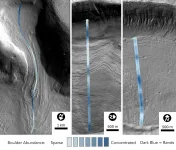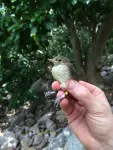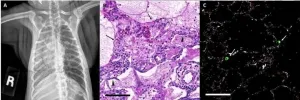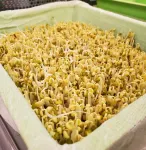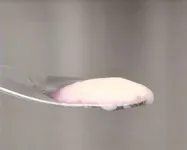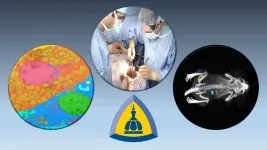(Press-News.org) In a new paper published today in the Proceedings of the National Academies of ScienceS (PNAS), planetary geologist Joe Levy, assistant professor of geology at Colgate University, reveals a groundbreaking new analysis of the mysterious glaciers of Mars.
On Earth, glaciers covered wide swaths of the planet during the last Ice Age, which reached its peak about 20,000 years ago, before receding to the poles and leaving behind the rocks they pushed behind. On Mars, however, the glaciers never left, remaining frozen on the Red Planet's cold surface for more than 300 million years, covered in debris. "All the rocks and sand carried on that ice have remained on the surface," says Levy. "It's like putting the ice in a cooler under all those sediments."
Geologists, however, haven't been able to tell whether all of those glaciers formed during one massive Martian Ice Age, or in multiple separate events over millions of years. Since ice ages result from a shift in the tilt of a planet's axis (known as obliquity), answering that question could tell scientists how Mars' orbit and climate have changed over time -- as well as what kind of rocks, gases, or even microbes might be trapped inside the ice.
"There are really good models for Mars' orbital parameters for the last 20 million years," says Levy. "After that the models tend to get chaotic."
Levy concocted a plan to examine the rocks on the surface of the glaciers as a natural experiment. Since they presumably erode over time, a steady progression of larger to smaller rocks proceeding downhill would point to a single, long ice age event.
Choosing 45 glaciers to examine, Levy acquired high-resolution images collected by the Mars Reconnaissance Orbiter satellite and set out to count the size and number of rocks. With a resolution of 25 centimeters per pixel, "you can see things the size of a dinner table," Levy says.
Even at that magnification, however, artificial intelligence can't accurately determine what is or isn't a rock on rough glacier surfaces; so Levy enlisted the help of 10 Colgate students during two summers to count and measure some 60,000 big rocks. "We did a kind of virtual field work, walking up and down these glaciers and mapping the boulders," Levy says.
Levy initially panicked when, far from a tidy progression of boulders by size, the rock sizes seemed to be distributed at random. "In fact, the boulders were telling us a different story," Levy says. "It wasn't their size that mattered; it was how they were grouped or clustered."
Since the rocks were traveling inside the glaciers, they were not eroding, he realized. At the same time, they were distributed in clear bands of debris across the glaciers' surfaces, marking the limit of separate and distinct flows of ice, formed as Mars wobbled on its axis.
Based on that data, Levy has concluded that Mars has undergone somewhere between six and 20 separate ice ages during the past 300-800 million years. Those findings appear in PNAS, written along with six current or former Colgate students; Colgate mathematics professor Will Cipolli; and colleagues from NASA, the University of Arizona, Fitchburg State University, and the University of Texas-Austin.
"This paper is the first geological evidence of what Martian orbit and obliquity might have been doing for hundreds of millions of years," Levy says. The finding that glaciers formed over time holds implications for planetary geology and even space exploration, he explains. "These glaciers are little time capsules, capturing snapshots of what was blowing around in the Martian atmosphere," he says. "Now we know that we have access to hundreds of millions of years of Martian history without having to drill down deep through the crust -- we can just take a hike along the surface."
That history includes any signs of life potentially present from Mars' distant past. "If there are any biomarkers blowing around, those are going to be trapped in the ice too." At the same time, eventual explorers to Mars who might need to depend on extracting fresh water from glaciers to survive will need to know that there may be bands of rocks inside them that will make drilling hazardous. Levy and his colleagues are now in the process of mapping the rest of the glaciers on Mars' surface, hoping with the data they have, artificial intelligence can now we trained to take over the hard work of identifying and counting boulders.
That will bring us one step closer to a complete planetary history of the Red Planet -- including the age-old question of whether Mars could ever have supported life.
"There's a lot of work to be done figuring out the details of Martian climate history," says Levy, "including when and where it was warm enough and wet enough for there to be brines and liquid water."
INFORMATION:
ATLANTA--Early in the U.S. COVID-19 pandemic, unemployment claims were largely driven by state shutdown orders and the nature of a state's economy and not by the virus, according a new article by Georgia State University economists.
David Sjoquist and Laura Wheeler found no evidence the Payroll Protection Program (PPP) affected the number of initial claims during the first six weeks of the pandemic.
Their research explores state differences in the magnitude of weekly unemployment insurance claims for the weeks ending March 14 through April 25 by focusing on three factors: the impact of COVID-19, the effects of state economic structures and state orders closing non-essential ...
The offspring of older animals often have a lower chance of survival because the parents are unable to take care of their young as well as they should. The Seychelles warbler is a cooperatively breeding bird species, meaning that parents often receive help from other birds when raising their offspring. A study led by biologists from the University of Groningen shows that the offspring of older females have better prospects when they are surrounded by helpers. This impact of social behaviour on reproductive success is described in a paper that was published ...
Philadelphia, January 19, 2021 - Aged, wild-caught African green monkeys exposed to the SARS-CoV-2 virus developed acute respiratory distress syndrome (ARDS) with clinical symptoms similar to those observed in the most serious human cases of COVID-19, report researchers in The American Journal of Pathology, published by Elsevier. This is the first study to show that African green monkeys can develop severe clinical disease after SARS-CoV-2 infection, suggesting that they may be useful models for the study of COVID-19 in humans.
"Animal models greatly enhance our understanding of diseases. The lack of an animal model for severe manifestations of COVID-19 has hampered our understanding of this form of the disease," explained lead investigator Robert V. Blair, DVM, PhD, ...
ATLANTA--Georgia State University biology researchers have found that infecting the nasal passages of mice with the virus that causes COVID-19 led to a rapid, escalating attack on the brain that triggered severe illness, even after the lungs were successfully clearing themselves of the virus.
Assistant professor Mukesh Kumar, the study's lead researcher, said the findings have implications for understanding the wide range in symptoms and severity of illness among humans who are infected by SARS-CoV-2, the virus that causes COVID-19.
"Our thinking that it's more of a respiratory disease is not necessarily ...
HOUSTON - (Jan. 19, 2021) - Carbon nanotube fibers are not nearly as strong as the nanotubes they contain, but Rice University researchers are working to close the gap.
A computational model by materials theorist Boris Yakobson and his team at Rice's Brown School of Engineering establishes a universal scaling relationship between nanotube length and friction between them in a bundle, parameters that can be used to fine-tune fiber properties for strength.
The model is a tool for scientists and engineers who develop conductive fibers for aerospace, automotive, medical and textile applications like smart clothing. Carbon nanotube fibers have been considered as a possible basis for a space elevator, a project Yakobson has studied.
The research ...
Scleroderma, a chronic and currently incurable orphan disease where tissue injury causes potentially lethal skin and lung scarring, remains poorly understood.
However, the defining characteristic of systemic sclerosis, the most serious form of scleroderma, is irreversible and progressive scarring that affects the skin and internal organs.
Published in iScience, Michigan Medicine's Scleroderma Program and the rheumatology and dermatology departments partnered with the Northwestern Scleroderma Program in Chicago and Mayo Clinic to investigate the causes of ...
Researchers have revealed the first atomic structures of the respiratory apparatus that plants use to generate energy, according to a study published today in eLife.
The 3D structures of these large protein assemblies - the first described for any plant species - are a step towards being able to develop improved herbicides that target plant respiration. They could also aid the development of more effective pesticides, which target the pest's metabolism while avoiding harm to crops.
Most organisms use respiration to harvest energy from food. Plants use photosynthesis to convert sunlight into sugars, and then respiration to break down the sugars into energy. This involves tiny cell components called mitochondria and a set of five protein assemblies ...
Provincial and territorial governments should set clear rules for vaccinating health care workers against SARS-CoV-2, the virus that causes COVID-19, in public and private settings, and should not leave this task to employers, according to an analysis in CMAJ (Canadian Medical Association Journal).
"An effective vaccine provided to health care workers will protect both the health workforce and patients, reducing the overall burden of COVID-19 on services and ensuring adequate personnel to administer to people's health needs through the pandemic," writes Dr. Colleen M. Flood, University of Ottawa Research Chair in Health Law & Policy and a ...
HAMILTON, ON, Jan. 19, 2021 -- McMaster researchers have developed a new form of cultivated meat using a method that promises more natural flavour and texture than other alternatives to traditional meat from animals.
Researchers Ravi Selvaganapathy and Alireza Shahin-Shamsabadi, both of the university's School of Biomedical Engineering, have devised a way to make meat by stacking thin sheets of cultivated muscle and fat cells grown together in a lab setting. The technique is adapted from a method used to grow tissue for human transplants.
The sheets of living cells, each about the thickness of a sheet of printer paper, are first grown in culture and then concentrated on growth plates before being peeled ...
NANOTECHNOLOGY PREVENTS PREMATURE BIRTH IN MOUSE STUDIES
Media Contact: Rachel Butch, rbutch1@jhmi.edu
In a study in mice and human cells, Johns Hopkins Medicine researchers say that they have developed a tiny, yet effective method for preventing premature birth. The vaginally delivered treatment contains nanosized (billionth of a meter) particles of drugs that easily penetrate the vaginal wall to reach the uterine muscles and prevent them from contracting. If proven effective in humans, the treatment could be one of the only clinical options available to prevent ...
